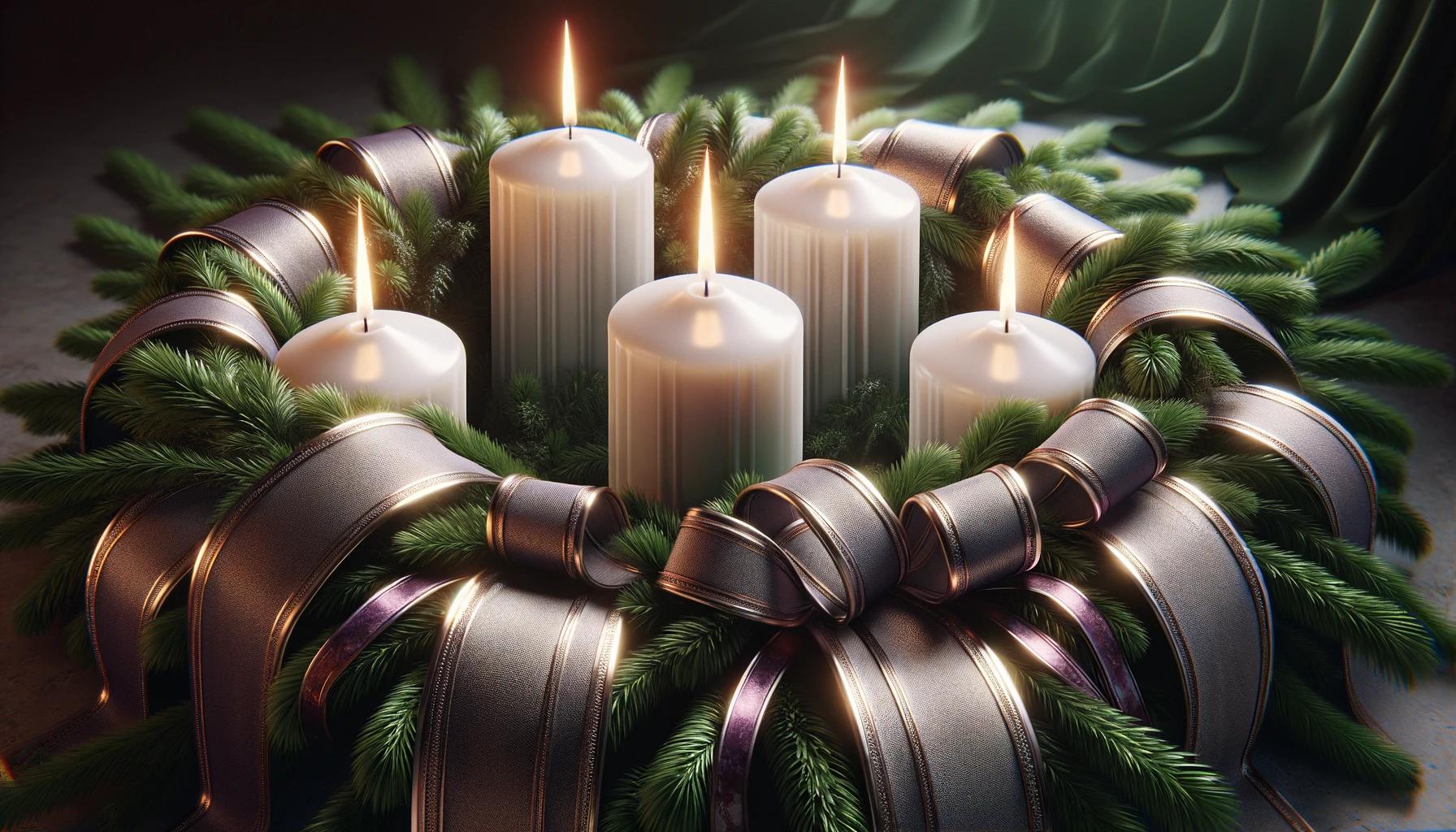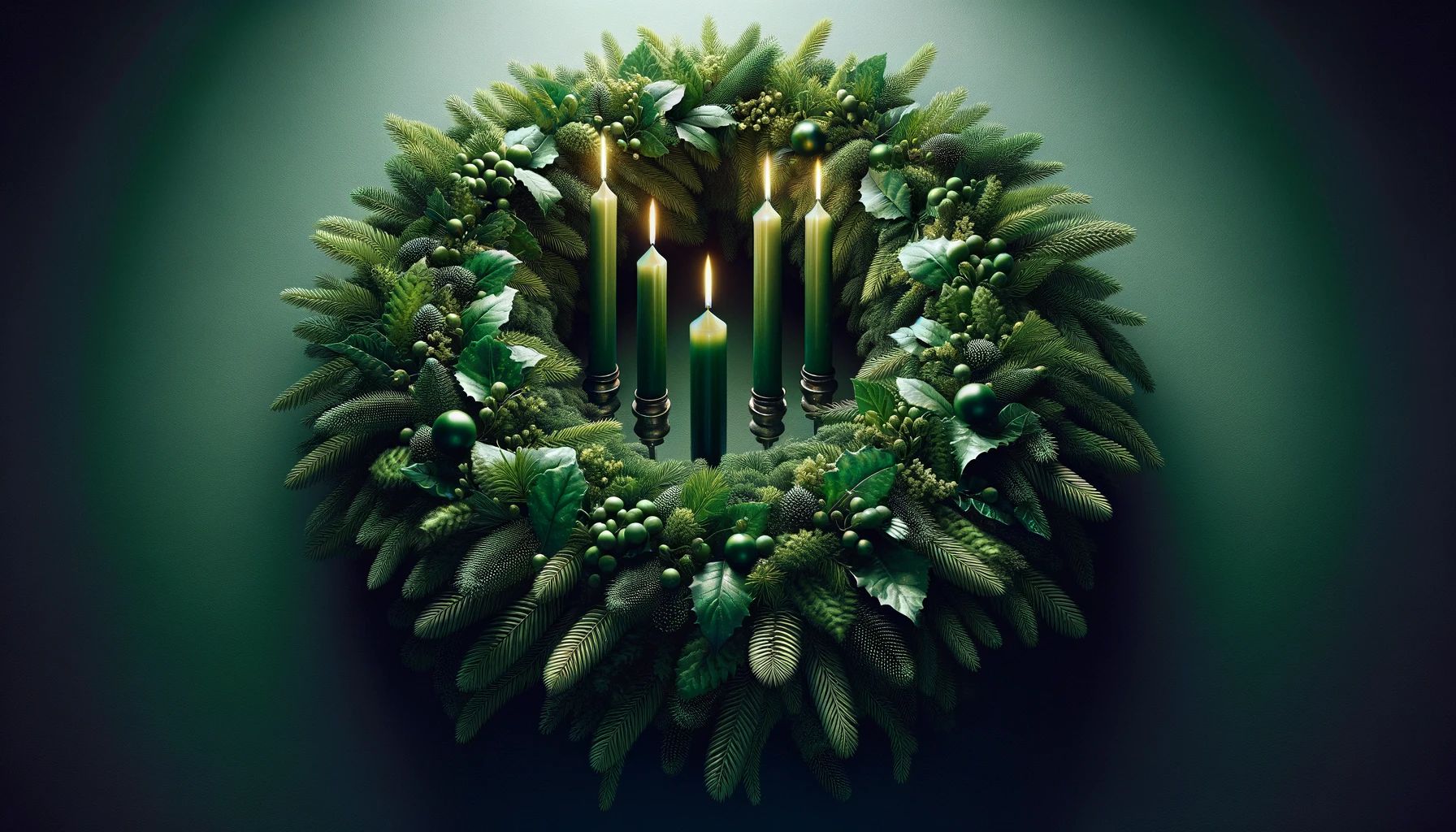Home>Special Themes>What Do You Do With An Advent Wreath


Special Themes
What Do You Do With An Advent Wreath
Published: February 12, 2024
Ericka Andersen, an editor at Christian.net, expertly merges digital strategy with content creation, focusing on faith and societal issues. Her communication skills enhance the platform's engaging narratives, fostering meaningful dialogue on belief's impact on society.
Discover creative ideas for using an advent wreath and incorporating special themes to make your celebrations even more meaningful. Explore unique ways to enhance your holiday traditions.
(Many of the links in this article redirect to a specific reviewed product. Your purchase of these products through affiliate links helps to generate commission for Christian.net, at no extra cost. Learn more)
Table of Contents
Introduction
The Advent wreath, a cherished symbol of the Advent season, holds a significant place in the hearts of many individuals and families around the world. As the holiday season approaches, the Advent wreath takes center stage in homes, churches, and communities, serving as a poignant reminder of the anticipation and preparation for the celebration of Christmas.
The Advent wreath, typically crafted from evergreen foliage and adorned with candles, serves as a visual representation of the passage of time and the spiritual journey towards the birth of Jesus Christ. Its circular shape symbolizes eternity and the unending love of God, while the evergreen branches signify hope and renewal. The candles, often arranged in a circle, represent the four weeks of Advent, with each candle holding its own unique significance.
This timeless tradition has been passed down through generations, fostering a sense of unity and spiritual reflection among those who partake in its observance. The lighting of the Advent candles, accompanied by prayers and readings, creates a serene and contemplative atmosphere, allowing individuals to pause and meditate on the profound meaning of the season.
The Advent wreath serves as a beacon of light and hope during the darker days of winter, illuminating the path towards the joyous celebration of the birth of Jesus. Its presence in homes and churches fosters a sense of anticipation and excitement, reminding believers of the profound significance of the Christmas season.
As we delve deeper into the history, symbolism, and customs associated with the Advent wreath, we will uncover the rich tapestry of traditions that have woven this cherished symbol into the fabric of the holiday season. Join us on a journey of exploration and discovery as we unravel the timeless allure of the Advent wreath and the profound significance it holds for countless individuals and communities worldwide.
Read more: What Do Advent Wreath Candles Represent
History of the Advent Wreath
The history of the Advent wreath traces its origins to pre-Christian Germanic and Scandinavian cultures, where the use of evergreen wreaths during the winter solstice symbolized life, light, and hope amidst the darkness of winter. As Christianity spread throughout these regions, the symbolism of the wreath was seamlessly integrated into the observance of Advent, the period of spiritual preparation leading up to Christmas.
The earliest documented use of an Advent wreath dates back to the 16th century in Germany, where both Catholics and Protestants adopted the tradition of lighting candles on a wreath as a part of their spiritual preparations for Christmas. Initially, the Advent wreath was a simple ring of evergreen foliage, adorned with four candles, each representing one of the four weeks of Advent.
Over time, the symbolism and customs associated with the Advent wreath evolved, with additional layers of meaning being woven into its significance. The circular shape of the wreath came to represent the eternal nature of God, with no beginning or end, while the evergreen branches symbolized the enduring hope and life found in Christ.
The tradition of the Advent wreath gradually spread throughout Europe and eventually made its way to North America, where it was embraced by various Christian denominations. Today, the Advent wreath holds a prominent place in the liturgical celebrations of many churches, as well as in the homes of countless individuals and families.
The rich history of the Advent wreath serves as a testament to the enduring power of tradition and symbolism in the Christian faith. Its evolution from a simple wreath with candles to a profound symbol of spiritual anticipation and hope reflects the deep-rooted significance of the Advent season in the hearts of believers worldwide. As we continue to explore the symbolism and customs associated with the Advent wreath, we gain a deeper appreciation for the timeless traditions that have shaped the observance of Advent and enriched the spiritual journey towards Christmas.
Symbolism of the Advent Wreath
The Advent wreath is steeped in rich symbolism, with each element holding profound significance that resonates deeply with the spiritual journey of Advent. The circular shape of the wreath represents eternity, with no beginning or end, mirroring the everlasting nature of God's love and the continuous cycle of the liturgical year. This timeless symbol serves as a poignant reminder of the unending presence of God in the lives of believers and the eternal hope found in the promise of salvation.
The evergreen foliage used to craft the Advent wreath holds its own symbolic weight, representing the enduring nature of faith and the hope that springs eternal in the hearts of believers. In the midst of winter, when the natural world lies dormant and barren, the evergreen branches serve as a powerful symbol of life, renewal, and the unyielding promise of new beginnings. The vibrant greenery serves as a visual testament to the resilience of faith and the unwavering hope that sustains individuals through the darkest of times.
Central to the symbolism of the Advent wreath are the candles, each imbued with its own unique meaning. Traditionally, the wreath holds four candles, three purple and one rose, arranged around the evergreen circle. The first purple candle, known as the "Prophecy Candle" or "Hope Candle," signifies the eager anticipation of the coming Messiah and the hope that permeates the hearts of believers as they await the fulfillment of God's promises. The second purple candle, often referred to as the "Bethlehem Candle" or "Preparation Candle," symbolizes the preparation and readiness for the arrival of the Christ child, prompting introspection and spiritual readiness. The rose candle, lit on the third Sunday of Advent, represents joy and rejoicing, marking a brief respite in the penitential season as believers celebrate the imminent arrival of the Savior. The final purple candle, known as the "Angels' Candle" or "Love Candle," embodies the boundless love of God, manifested in the gift of His Son to humanity, and serves as a poignant reminder of the profound love that underpins the Christmas narrative.
As the Advent season unfolds, the gradual lighting of the candles on the wreath serves as a visual representation of the increasing light and hope that emanate from the anticipation of Christ's birth. Each candle illuminates the path towards Christmas, guiding believers through a period of spiritual reflection, preparation, and joyful expectation.
The symbolism of the Advent wreath, with its circular form, evergreen foliage, and carefully positioned candles, weaves a tapestry of meaning that resonates deeply with the hearts of believers, fostering a sense of unity, hope, and spiritual contemplation as they journey towards the celebration of the birth of Jesus Christ.
How to Make an Advent Wreath
Creating your own Advent wreath can be a meaningful and fulfilling endeavor, allowing you to infuse this cherished symbol with personal significance and creativity. To embark on this craft, you will need a few essential materials and a touch of inspiration to guide you through the process.
Materials Needed:
-
Wreath Base: Begin by selecting a wreath base, traditionally made of evergreen foliage, which can be crafted from fresh or artificial greenery. The circular shape of the wreath base symbolizes eternity and the unending nature of God's love.
-
Candles: You will need four candles to represent the four weeks of Advent. Typically, three purple candles and one rose candle are used, each embodying distinct meanings of hope, preparation, joy, and love.
-
Candle Holders: Ensure you have suitable candle holders to secure the candles to the wreath base securely.
-
Decorative Accents: Consider incorporating decorative elements such as ribbons, pinecones, berries, or other adornments to enhance the visual appeal of your Advent wreath.
Step-by-Step Guide:
-
Prepare the Wreath Base: If using fresh evergreen foliage, shape the branches into a circular form, securing them together with floral wire. For artificial wreath bases, ensure that the foliage is evenly distributed and fluffed to create a lush and full appearance.
-
Position the Candles: Place the four candles equidistant from each other on the wreath base, ensuring that they are firmly secured in their holders. The arrangement typically includes three purple candles and one rose candle, with the rose candle positioned at the center.
-
Add Decorative Accents: Embellish the wreath with decorative accents, such as ribbons, pinecones, or berries, to add a touch of festive charm and personal flair to your creation.
-
Personalize with Meaningful Elements: Consider incorporating symbolic elements that hold personal significance, such as small ornaments, religious symbols, or meaningful trinkets, to infuse your Advent wreath with deeper meaning.
-
Prepare for Lighting: Prior to the first Sunday of Advent, ensure that your wreath is positioned in a safe and central location, ready to be lit ceremoniously as the season unfolds.
Crafting your own Advent wreath provides an opportunity for reflection and intentionality as you prepare for the Advent season. Each element, from the selection of materials to the arrangement of candles, offers a chance to imbue your creation with personal significance and spiritual resonance, enriching the observance of this cherished tradition.
Lighting the Advent Wreath
The ceremonial lighting of the Advent wreath holds profound significance, marking the progression of the Advent season and illuminating the path towards the joyous celebration of Christmas. Each week of Advent, beginning on the first Sunday, is accompanied by the symbolic lighting of a candle on the wreath, with each candle representing a distinct theme and spiritual focus.
On the first Sunday of Advent, the initial purple candle, known as the "Prophecy Candle" or "Hope Candle," is ceremoniously lit, signifying the eager anticipation of the coming Messiah and the hope that permeates the hearts of believers as they await the fulfillment of God's promises. This act of lighting the first candle serves as a poignant reminder of the prophetic anticipation of the Savior's arrival and the enduring hope that sustains individuals through the season of Advent.
As the second week of Advent unfolds, the first purple candle remains lit, and a second purple candle, often referred to as the "Bethlehem Candle" or "Preparation Candle," is ceremonially kindled. This act of lighting the second candle symbolizes the preparation and readiness for the arrival of the Christ child, prompting introspection and spiritual readiness as believers journey towards the celebration of Christmas.
On the third Sunday of Advent, known as Gaudete Sunday, the rose candle, representing joy and rejoicing, is lit, infusing the season with a sense of anticipation and celebration. The lighting of the rose candle offers a brief respite in the penitential season, inviting believers to rejoice in the imminent arrival of the Savior and to embrace the profound joy that accompanies the Christmas narrative.
Finally, as the fourth week of Advent commences, the third purple candle, known as the "Angels' Candle" or "Love Candle," is ceremonially kindled, embodying the boundless love of God manifested in the gift of His Son to humanity. The act of lighting the fourth candle serves as a poignant reminder of the profound love that underpins the Christmas narrative and invites believers to reflect on the transformative power of divine love.
The gradual illumination of the Advent wreath, week by week, serves as a visual representation of the increasing light and hope that emanate from the anticipation of Christ's birth. Each candle, carefully kindled in succession, guides believers through a period of spiritual reflection, preparation, and joyful expectation, culminating in the radiant celebration of Christmas.
The act of lighting the Advent wreath, accompanied by prayers, readings, and contemplative moments, fosters a sense of unity and spiritual contemplation, inviting individuals to pause and meditate on the profound significance of the season. As the warm glow of the candles illuminates the darkness, it serves as a beacon of hope and a poignant reminder of the profound anticipation and joy that accompany the Advent season.
Traditions and Customs Associated with the Advent Wreath
The observance of the Advent wreath is steeped in rich traditions and customs that have been passed down through generations, enriching the spiritual journey of believers as they prepare for the celebration of Christmas. These time-honored practices infuse the Advent season with depth and meaning, fostering a sense of unity and spiritual reflection among individuals and communities worldwide.
One of the enduring traditions associated with the Advent wreath is the practice of incorporating specific prayers and readings into the lighting ceremony. Each week of Advent is accompanied by designated scripture readings and prayers that align with the themes represented by the lit candles. These readings often draw from prophetic passages, Psalms, and the Gospels, inviting participants to engage in moments of contemplation and spiritual introspection as they journey through the season.
In many households and churches, the lighting of the Advent wreath becomes a communal ritual, bringing together families, congregations, and communities in a shared expression of faith and anticipation. The act of gathering around the wreath, kindling the candles, and engaging in collective prayer and reflection fosters a sense of unity and solidarity, reinforcing the significance of the Advent season as a time of spiritual preparation and joyful expectation.
Another cherished custom associated with the Advent wreath is the incorporation of symbolic elements and rituals that vary across different cultural and religious traditions. For example, some traditions involve the blessing of the Advent wreath by a clergy member, infusing the wreath with sacred significance and invoking God's presence and blessings upon the upcoming season. Additionally, certain customs may involve the inclusion of specific hymns, carols, or musical accompaniments during the lighting ceremony, adding a melodic dimension to the observance of Advent.
The Advent wreath also serves as a focal point for family devotions and spiritual conversations, providing a platform for parents to engage their children in meaningful discussions about the significance of the season. This tradition fosters a sense of continuity and spiritual nurturing within families, as younger generations are initiated into the timeless customs and beliefs that underpin the observance of Advent.
As the Advent season unfolds, the customs and traditions associated with the Advent wreath serve to deepen the spiritual significance of this cherished symbol, fostering a sense of reverence, anticipation, and unity among believers. These enduring practices enrich the observance of Advent, infusing the season with profound meaning and spiritual resonance as individuals and communities journey towards the celebration of the birth of Jesus Christ.
Conclusion
In conclusion, the Advent wreath stands as a timeless symbol of hope, anticipation, and spiritual preparation as believers journey towards the celebration of Christmas. Its rich history, steeped in tradition and symbolism, reflects the enduring power of faith and the profound significance of the Advent season in the hearts of individuals and communities worldwide.
The evolution of the Advent wreath from its pre-Christian origins to its integration into the observance of Advent within Christian traditions underscores the enduring relevance of its symbolism. The circular form, evergreen foliage, and carefully positioned candles weave a tapestry of meaning that resonates deeply with the hearts of believers, fostering a sense of unity, hope, and spiritual contemplation.
The act of crafting an Advent wreath, whether through traditional or personalized elements, provides an opportunity for reflection and intentionality, allowing individuals to infuse this cherished symbol with personal significance and creativity. The ceremonial lighting of the Advent wreath, accompanied by prayers, readings, and contemplative moments, fosters a sense of unity and spiritual contemplation, inviting individuals to pause and meditate on the profound significance of the season.
The observance of the Advent wreath is further enriched by the rich traditions and customs associated with its lighting and incorporation of prayers, readings, and communal rituals. These time-honored practices infuse the Advent season with depth and meaning, fostering a sense of unity and spiritual reflection among individuals and communities worldwide.
As we reflect on the profound symbolism and traditions surrounding the Advent wreath, we are reminded of the enduring hope and joy that permeate the season. The gradual illumination of the candles on the Advent wreath serves as a visual representation of the increasing light and hope that emanate from the anticipation of Christ's birth, guiding believers through a period of spiritual reflection, preparation, and joyful expectation.
In essence, the Advent wreath serves as a poignant reminder of the timeless themes of hope, love, joy, and preparation that underpin the Advent season, inviting believers to embark on a spiritual journey of anticipation and renewal as they prepare to celebrate the birth of Jesus Christ. As the warm glow of the candles illuminates the darkness, the Advent wreath stands as a beacon of hope and a poignant reminder of the profound anticipation and joy that accompany the Advent season.














